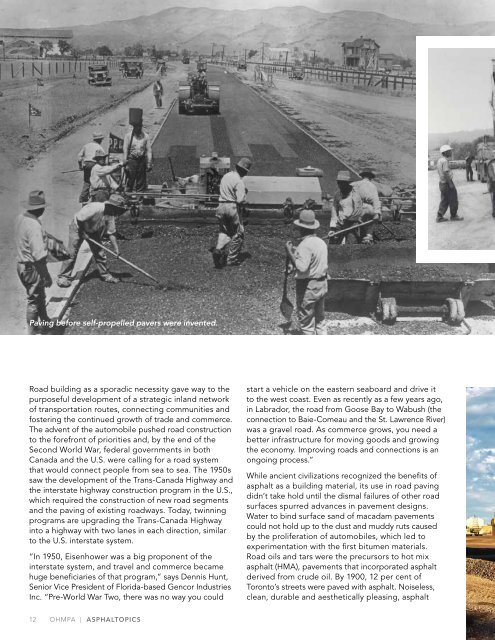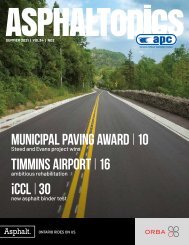ASPHALTopics | Fall 2015 | VOL 28 | NO 3
You also want an ePaper? Increase the reach of your titles
YUMPU automatically turns print PDFs into web optimized ePapers that Google loves.
Paving before self-propelled pavers were invented.<br />
Road building as a sporadic necessity gave way to the<br />
purposeful development of a strategic inland network<br />
of transportation routes, connecting communities and<br />
fostering the continued growth of trade and commerce.<br />
The advent of the automobile pushed road construction<br />
to the forefront of priorities and, by the end of the<br />
Second World War, federal governments in both<br />
Canada and the U.S. were calling for a road system<br />
that would connect people from sea to sea. The 1950s<br />
saw the development of the Trans-Canada Highway and<br />
the interstate highway construction program in the U.S.,<br />
which required the construction of new road segments<br />
and the paving of existing roadways. Today, twinning<br />
programs are upgrading the Trans-Canada Highway<br />
into a highway with two lanes in each direction, similar<br />
to the U.S. interstate system.<br />
“In 1950, Eisenhower was a big proponent of the<br />
interstate system, and travel and commerce became<br />
huge beneficiaries of that program,” says Dennis Hunt,<br />
Senior Vice President of Florida-based Gencor Industries<br />
Inc. “Pre-World War Two, there was no way you could<br />
start a vehicle on the eastern seaboard and drive it<br />
to the west coast. Even as recently as a few years ago,<br />
in Labrador, the road from Goose Bay to Wabush (the<br />
connection to Baie-Comeau and the St. Lawrence River)<br />
was a gravel road. As commerce grows, you need a<br />
better infrastructure for moving goods and growing<br />
the economy. Improving roads and connections is an<br />
ongoing process.”<br />
While ancient civilizations recognized the benefits of<br />
asphalt as a building material, its use in road paving<br />
didn’t take hold until the dismal failures of other road<br />
surfaces spurred advances in pavement designs.<br />
Water to bind surface sand of macadam pavements<br />
could not hold up to the dust and muddy ruts caused<br />
by the proliferation of automobiles, which led to<br />
experimentation with the first bitumen materials.<br />
Road oils and tars were the precursors to hot mix<br />
asphalt (HMA), pavements that incorporated asphalt<br />
derived from crude oil. By 1900, 12 per cent of<br />
Toronto’s streets were paved with asphalt. Noiseless,<br />
clean, durable and aesthetically pleasing, asphalt<br />
12 OHMPA | ASPHALTOPICS


















